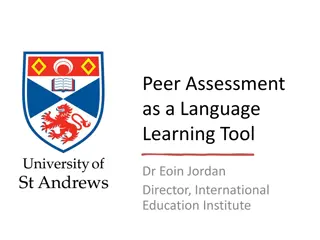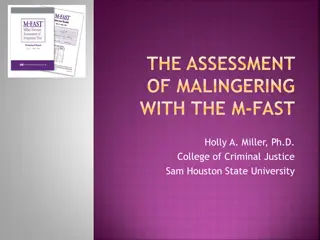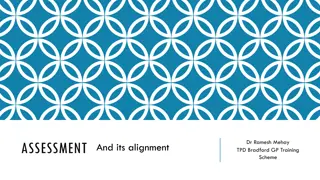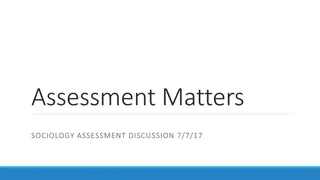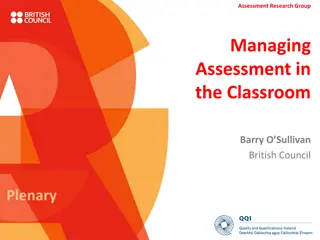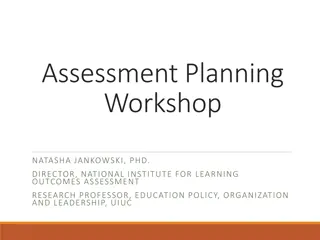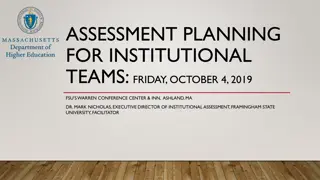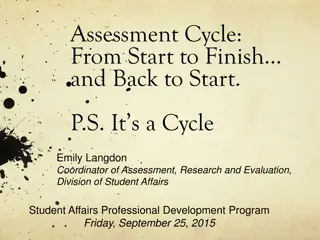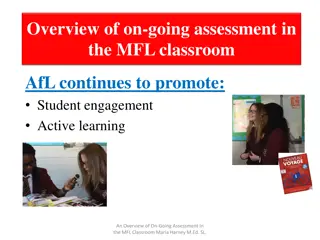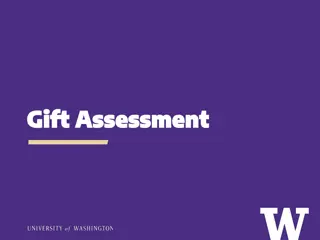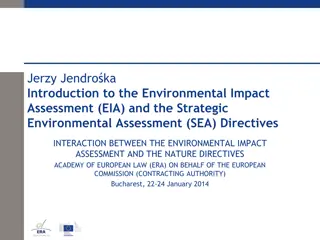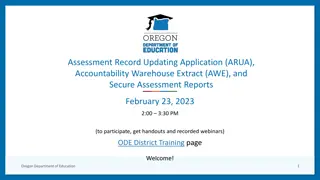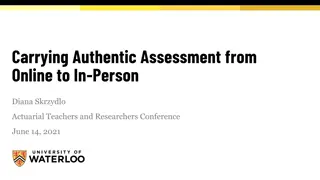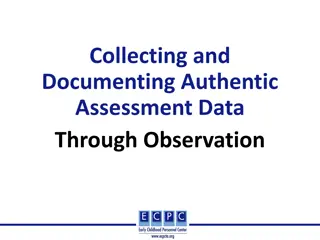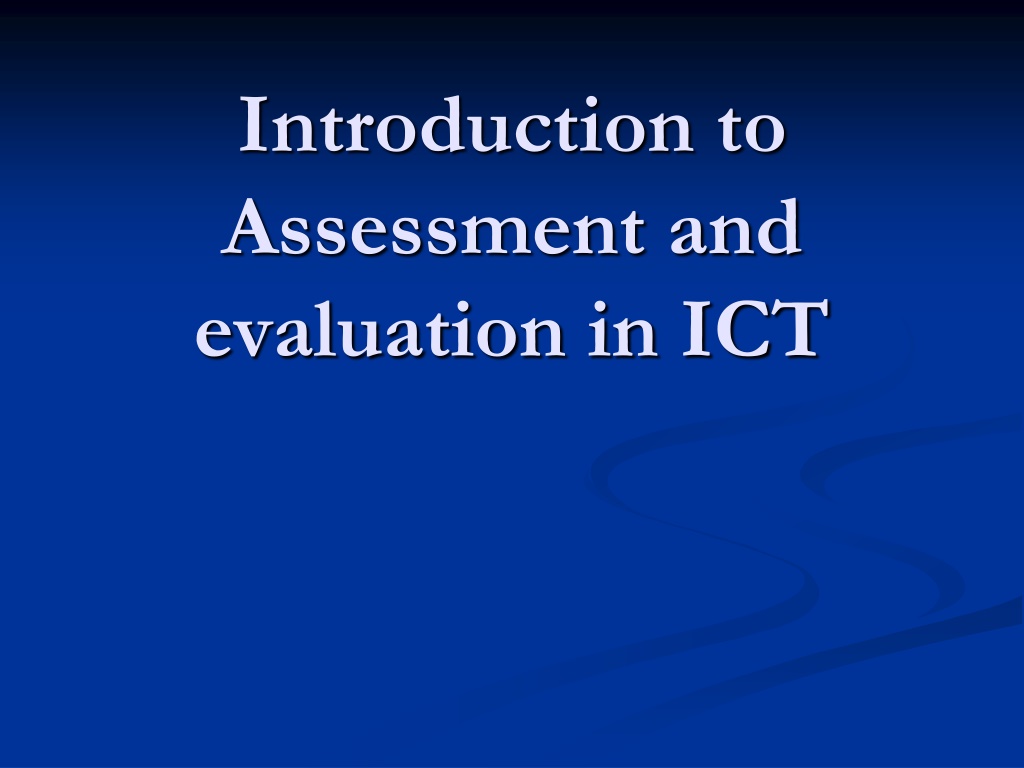
Understanding Assessment and Evaluation in ICT
Explore the concepts of assessment and evaluation in ICT, distinguishing between formal and informal methods, traditional assessment techniques, norm and criterion-referenced tests, evaluation types, and the purposes of assessment in educational settings.
Download Presentation

Please find below an Image/Link to download the presentation.
The content on the website is provided AS IS for your information and personal use only. It may not be sold, licensed, or shared on other websites without obtaining consent from the author. If you encounter any issues during the download, it is possible that the publisher has removed the file from their server.
You are allowed to download the files provided on this website for personal or commercial use, subject to the condition that they are used lawfully. All files are the property of their respective owners.
The content on the website is provided AS IS for your information and personal use only. It may not be sold, licensed, or shared on other websites without obtaining consent from the author.
E N D
Presentation Transcript
Introduction to Assessment and evaluation in ICT
What is assessment? Not the same as testing! An ongoing process to ensure that the course/class objectives and goals are met. A process, not a product. A test is a form of assessment. (Brown, 2004, p. 5)
Informal and Formal Assessment Informal assessment can take a number of forms: unplanned comments, verbal feedback to students, observing students perform a task or work in small groups, and so on. Formal assessment are exercises or procedures which are: systematic give students and teachers an appraisal of students achievement such as tests.
Traditional Assessment Multiple-choice True-false Matching Norm-referenced and criterion referenced tests
Norm and Criterion-referenced tests Norm-referenced test standardized tests (college board, TOEFL, GRE) Place test-takers on a mathematical continuum in rank order Criterion-referenced tests give test-takers feedback on specific objectives ( criterea ) test objectives of a course known as instructional value
Evaluation Types Criterion-referenced evaluation -- student performance is assessed against a set of predetermined standards Norm-referenced evaluation -- student performance is assessed relative to the other students
Authentic Assessment Authentic assessment reflects student learning, achievement, motivation, and attitudes on instructionally relevant classroom activities (O Malley & Valdez, 1996). Examples: performance assessment portfolios self-assessment
Purposes for Assessment Diagnose students strengths and needs Provide feedback on student learning Provide a basis for instructional placement Inform and guide instruction Communicate learning expectations Motivate and focus students attention and effort Provide practice applying knowledge and skills
Purposes continued Provide a basis for evaluation for the purpose of: Grading Promotion/graduation Program admission/selection Accountability Gauge program effectiveness
Assessment Instruments Pre-assessment (diagnostic) Formative (ongoing) Summative (final) Teacher-made test Pretests Observations Journals/logs Discussions Questionnaires Interviews Quizzes Discussions Assignments Projects Observations Portfolios Journal logs Standardized tests Portfolios Projects Standardized tests
Discussion How would you document a student performance during a discussion?
Principles of ICT Assessment Practicality Reliability Validity Authenticity Washback
Practicality An effective test is practical Is not excessively expensive Stays within appropriate time constraints Is relatively easy to administer Has a scoring/evaluation procedure that is specific and time-efficient
Reliability A reliable test is consistent and dependable. If you give the same test to the same students in two different occasions, the test should yield similar results. Student-related reliability Rater reliability Test administration reliability Test reliability
Student Related Reliability The most common issue in student related reliability is caused by temporary illness, fatigue, a bad day, anxiety, and other physical and psychological factors which may make an observed score deviate from a true score.
Rater Reliability Human error, subjectivity, and bias may enter into the scoring process. Inter-rater reliability occurs when two or more scorers yield inconsistent scores of the same test, possibly for lack of attention to scoring criteria, inexperience, inattention, or even preconceived bias toward a particular good and bad student.
Test Administration Reliability Test administration reliability deals with the conditions in which the test is administered. Street noise outside the building bad equipment room temperature the conditions of chairs and tables, photocopying variation
Test Reliability The test is too long Poorly written or ambiguous test items
Validity A test is valid if it actually assess the objectives and what has been taught. Content validity Criterion validity (tests objectives) Construct validity Consequential validity Face validity
Content Validity A test is valid if the teacher can clearly define the achievement that he or she is measuring A test of tennis competency that asks someone to run a 100-yard dash lacks content validity If a teacher uses the communicative approach to teach speaking and then uses the audiolingual method to design test items, it is going to lack content validity
Criterion-related Validity The extent to which the objectives of the test have been measured or assessed. For instance, if you are assessing reading skills such as scanning and skimming information, how are the exercises designed to test these objectives? In other words, the test is valid if the objectives taught are the objectives tested and the items are actually testing this objectives.
Construct Validity A construct is an explanation or theory that attempts to explain observed phenomena If you are testing vocabulary and the lexical objective is to use the lexical items for communication, writing the definitions of the test will not match with the construct of communicative language use
Consequential Validity Accuracy in measuring intended criteria Its impact on the preparation of test-takers Its effect on the learner Social consequences of a test interpretation (exit exam for pre-basic students at El Colegio, the College Board)
Face Validity Face validity refers to the degree to which a test looks right, and appears to measure the knowledge or ability it claims to measure A well-constructed, expected format with familiar tasks A test that is clearly doable within the allotted time limit Directions are crystal clear Tasks that relate to the course (content validity) A difficulty level that presents a reasonable challenge
Authenticity The language in the test is as natural as possible Items are contextualized rather than isolated Topics are relevant and meaningful for learners Some thematic organization to items is provided Tasks represent, or closely approximate, real- world tasks
Washback Washback refers to the effects the tests have on instruction in terms of how students prepare for the test Cram courses and teaching to the test are examples of such washback In some cases the student may learn when working on a test or assessment Washback can be positive or negative
Alternative Assessment Options Self and peer-assessments Oral production-student self-checklist, peer checklist, offering and receiving holistic rating of an oral presentation Listening comprehension- listening to TV or radio broadcasts and checking comprehension with a partner Writing-revising work on your own, peer-editing Reading- reading textbook passages followed by self-check comprehension questions, self-assessment of reading habits (page 416, Brown, 2001)
Authentic Assessment Performance assessment- any form of assessment in which the student constructs a response orally or in writing. It requires the learner to accomplish a complex and significant task, while bringing to bear prior knowledge, recent learning, and relevant skills to solve realistic or authentic problems (O Malley & Valdez, 1996; Herman, et. al., 1992).
Examples of Authentic Assessment Portfolio assessment Student self-assessment Peer assessment Student-teacher conferences Oral interviews Writing samples Projects or exhibitions Experiments or demonstrations
Characteristics of performance assessment Constructed response Higher-order thinking Authenticity Integrative Process and product Depth versus breadth
Journals Specify to students the purpose of the journal Give clear directions to students on how to get started (prompts for instance I was very happy when ) Give guidelines on length of each entry Be clear yourself on the principal purpose of the journal Help students to process your feedback, and show them how to respond to your responses
Conferences Commonly used when teaching writing One-on-one interaction between teacher and student Conferences are formative assessment as opposed to offering a final grade or a summative assessment. In other words, they are meant to provide guidance and feedback.
Portfolios Commonly used with the communicative language teaching approach (CLT) It is a collection of students work that demonstrates to students and others the efforts, progress and achievements in a given area. You can have a reading portfolio or a writing portfolio, for instance You can also have a reflective or assessment portfolio as opposed to collecting every piece of evidence for each objective achieved in the course
Portfolio Guidelines Specify the purpose of the portfolio Give clear directions to students on how to get started Give guidelines of acceptable materials or artifacts Collect portfolios on a pre-announced dates and return promptly Help students to process your feedback Establish a rubric to evaluate the portfolio and discuss it with your students
Cooperative Test Construction Cooperative test construction involves the students contribution to the design of test items. It is based on the concept of collaborative and cooperative learning in which students are involved in the process. (Brown, 2001, p. 420)
TYPES OF TEST ITEMS (QUESTIONS)
TRUE-FALSE QUESTIONS
ADVANTAGES Allow many test items As They Can Be Answered Quickly Easy And Quick To Write Quick To Score Factual Information Is Easily Tested Standardized Answer Sheets Can Be Used
DISADVANTAGES Only First Level of Bloom s Taxonomy, Basic Knowledge, can be Tested 50% Chance of Guessing Answer Easy For a Person to Cheat Encourages Memorization Rather than Understanding Of Facts Can be Ambiguous Requires More Questions to Ensure Reliability
CONSTRUCTION PROCEDURES Keep Question Short Use Only a Single Concept in Each Question Keep Vocabulary Simple Do not Copy Statements Directly From the Text When Possible State the Items Positively Rather than Negatively
Cont Avoid Words Like Always, All, Never, Or None Do Not Allow More Than 60% Of The Items to have the Same Answer Avoid Long Strings of Items to have the same Answer
Cont Avoid Patterns in the Answers Do Not Give Clues in one item to Another Item Avoid Interdependent terms in items
MULTIPLE-CHOICE ITEMS (QUESTIONS)
ADVANTAGES Wide coverage as they can be answered Quickly Quickly Scored All Levels Of Bloom s Taxonomy (Knowledge, Comprehension, Application, Etc) can Be Tested Decreases Chance of Guessing Correctly Standardized Answer Sheets can be Used
DISADVANTAGES Fewer Items can be Asked Than With True- false Takes Time to think of Good Distractor Responses Some Danger to Cheating To Some Extent, Encourages Memorization Without Understanding Implications People are unable to Demonstrate the Extent of their Knowledge as they can only respond to the items written
CONSTRUCTION Keep stems & responses short Make all responses approximately the same length Use apparently acceptable answers for all responses Use 3-5 responses for each stem
Cont If stem is incomplete sentence, response should complete sentence Do not give away the answer with english usage Do not give away the answer to one item in the content of another item
CONSTRUCTION Do not allow the answer of one item to depend on the answer to another item Do not construct a stem that solicits a person s opinion Use letters (a, b, c, etc) to enumerate responses to numbered questions Try to equally use each letter as the correct response When possible, state the stem positively rather than negatively
MATCHING ITEMS (QUESTIONS)


